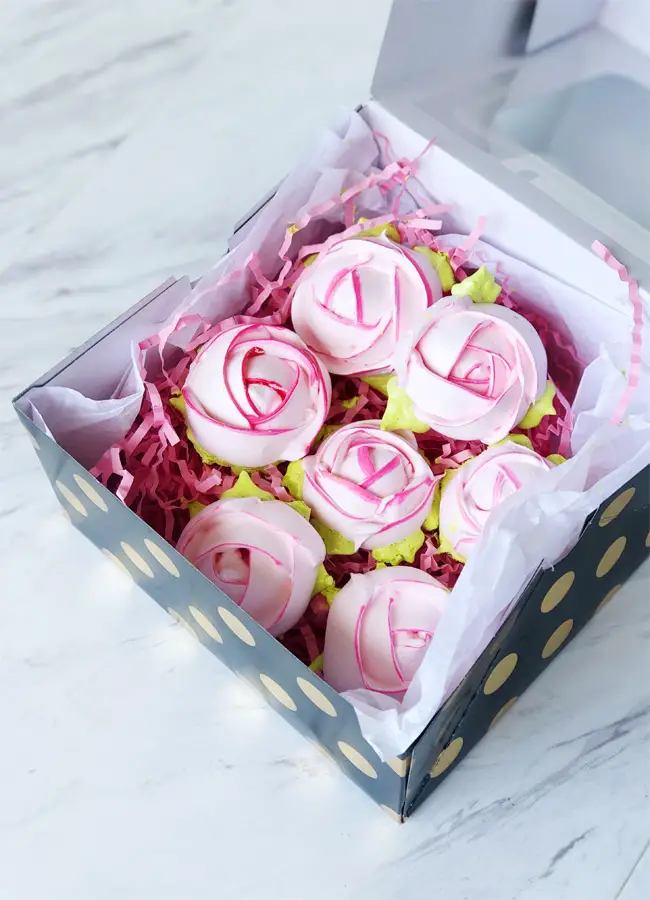
Today I’m going to show you how to make Italian Meringue. It’s the most dense and stable type of meringue, so it’s great for decorating cakes, cupcakes and pies, filling pastries, folding into other deserts, baking meringue cookies and of cause, making Italian meringue buttercream frosting.
The process of making Italian meringue is very simple, the only thing we’ll need is a candy thermometer. Now, the proportion: Italian meringue always works best with double the amount of sugar to egg white, so for 100g of egg whites we’ll need 200g of sugar, 60 ml water, a pinch of salt and a teaspoon of lemon juice.
Step 1
To make the syrup, combine the sugar and water in a heavy-bottomed saucepan. Instead of water you can also use concentrated juices to add flavor. If you would like to add color to the meringue, you can add it before cooking the syrup. I’m adding a little bit of pink gel food color for my future roses. Start to heat the syrup over medium heat.

Step 2
At the same time, in a stand mixer bowl combine the egg whites, pinch of salt and lemon juice. Also, you can add powdered colors to the egg whites before whisking. Whip the eggs whites on low speed until foamy, then increase the speed to medium and beat until soft peaks form. Make sure that the mixing bowl and the whisk attachment are very clean and there’s no residual oil or fat left behind to disturb or deflate the meringue.
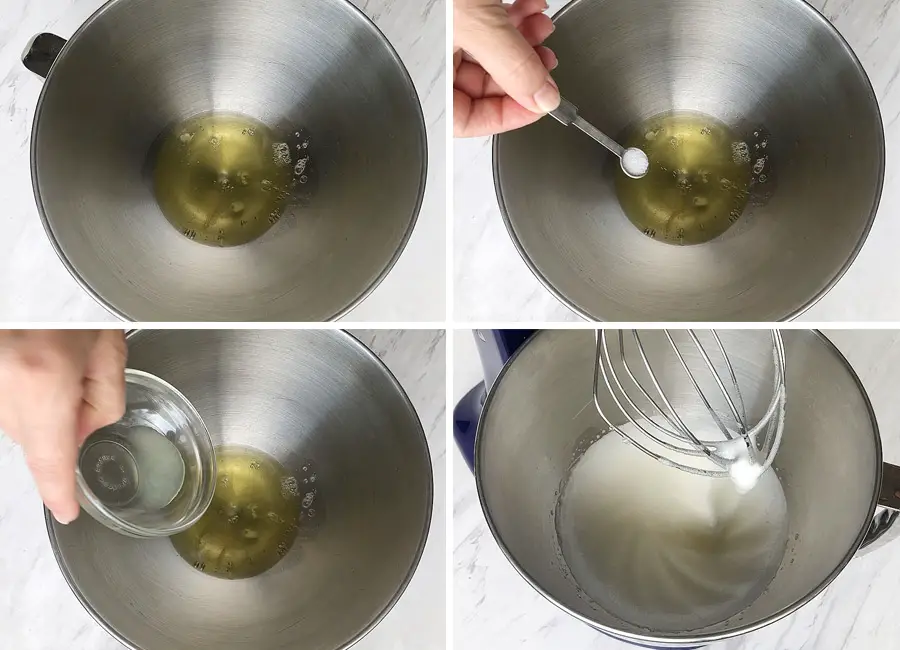
Step 3
Heat the sugar until it reaches 245°F. If the sugar syrup is ready but the egg whites are not at the stage of soft picks, add a little bit of water to the syrup to bring down the temperature. If the egg whites are already beaten but the syrup is not ready, reduce the mixer speed to low and whisk on low until the syrup is ready.
When the egg whites are at the stage of soft picks and the syrup reached the right temperature, turn the mixer on high speed and slowly pour the syrup down the side of the bowl into the egg whites. Continue the whipping until the bowl feels slightly warm to the touch. When you lift the whisk up, the meringue should be stiff and glossy. Use the meringue immediately or keep in the fridge properly covered until ready to use.
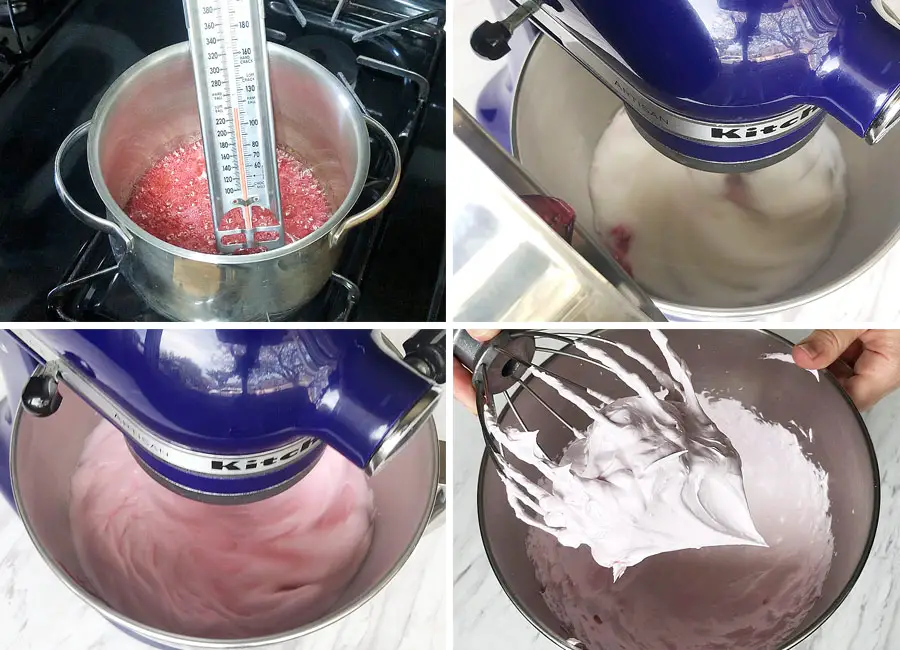
Step 4
For my roses I colored a small amount of meringue into a green color and the rest of the meringue I transferred into piping bags. One bag for making the base of the flower and the rest of it for my petals.
To make a rose, add a small amount of pink meringue in the middle of parchment paper square in the form of a cone to act as the base. Using piping tip number 127, with the wide edge of the tip down, slowly squeeze the piping bag to form one petal, making a rounded n-like (as in the letter n) movement. There will be three petals for the first row. Continue piping arcs that become larger as the rose increases in size. The petals should overlap a bit and the wide end of the tip always touches the rose base, so the petals will attach. Clean the tip before you start each petal by wiping any excess meringue off. Keep piping arcs to shape a rose. With a piping tip number 352 add some leaves around the flower for a finished look. As you can see, I also colored dark pink strip on the inside of the piping bag so that the edges of the rose come out darker.

Piping roses with meringue is a little bit harder than with buttercream because the mixture is less stable then buttercream. If you never piped roses before, I recommend you read my post about Piping Buttercream Roses where I talk in more detail about this process.
Step 5
When all the roses are piped, bake them at 170°-180°F degrees in an oven with convection, if possible, for 1.5-2 hours. Turn off the oven once the baking time has passed, and do not open the oven. Leave the oven door closed and allow the cookies to cool completely in the oven (1-2 hours) before removing.
When done, the meringues should easily peel off the parchment paper. Baked meringue cookies may be stored in a covered container at room temperature up to two weeks.
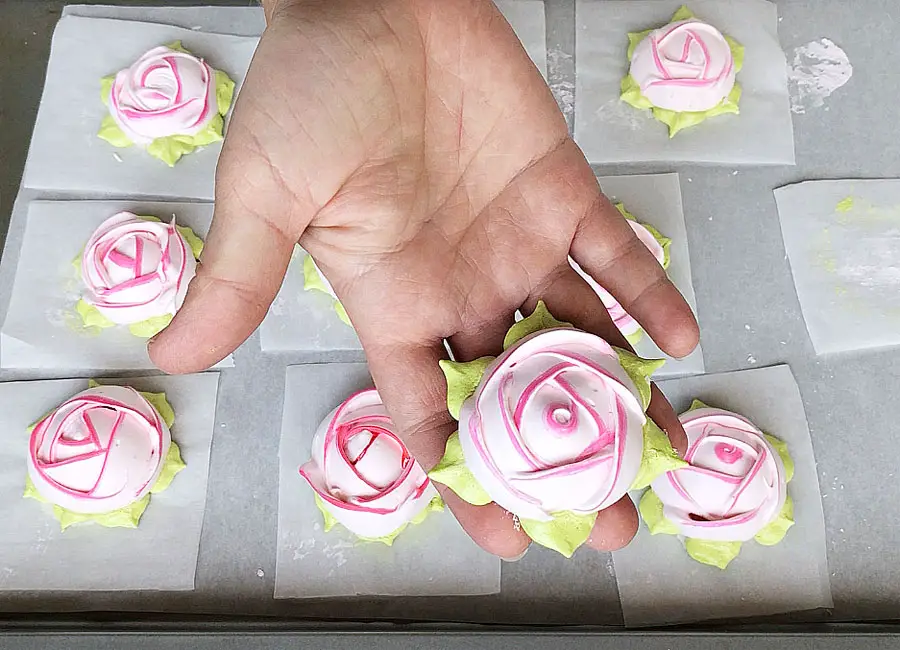
Step 6
It’s very easy to make your Italian meringue into buttercream. When meringue comes to room temperature and looks stiff and glossy, add 4 sticks (454g) of room-temperature butter one tablespoon at a time, mixing after each addition. Add 2 teaspoons of vanilla extract or any other flavor, if using, when the buttercream is almost ready. Beat until the butter is combined and mixture has reached a silky consistency.
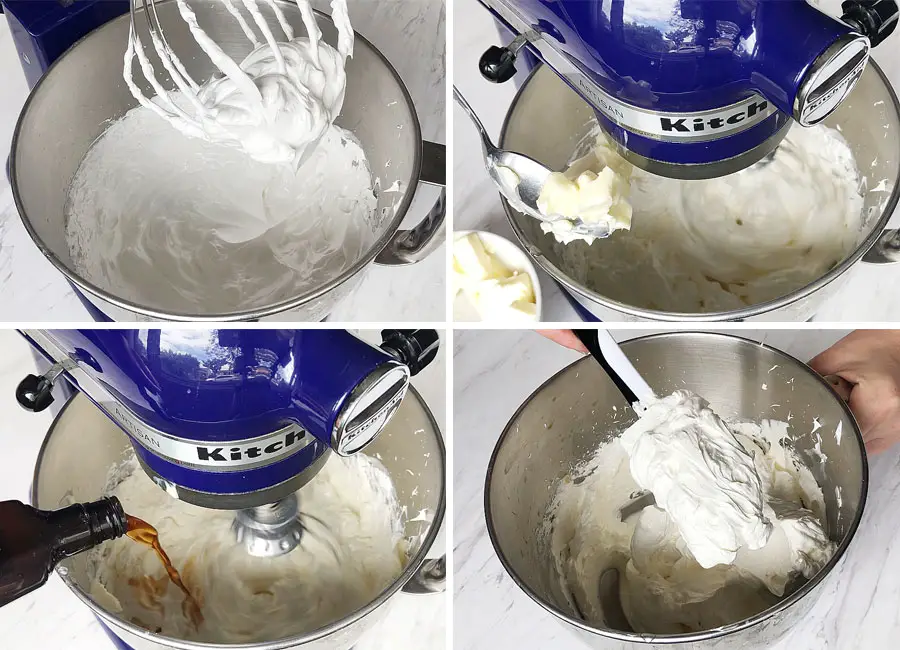
If you’re not using your buttercream immediately, you can refrigerate it for a few days in Ziplock bag or airtight container. Once you’re ready to use it, allow it to come to room temperature and whip again for a couple of minutes.
Notes:
You can color meringue during the making process or after the meringue is ready. Powdered colors may be added to the egg whites before whisking and gel food coloring may be added into the syrup before cooking the sugar.
Italian meringue can be made two days in advance and stored in the fridge until needed (covered with plastic wrap).
If you’re not using your buttercream immediately, you can refrigerate it for a few days in Ziplock bag or airtight container. Once you’re ready to use it, allow it to come to room temperature and whip again for a couple of minutes.
If my post was useful to you, please let me know in the comment section below.

Italian Meringue and Italian Meringue Buttercream
Ingredients
Method
- To make the syrup, combine the sugar and water in a heavy-bottomed saucepan. Instead of water you can also use concentrated juices to add flavor. If you would like to add color to the meringue, you can add it before cooking the syrup. I’m adding a little bit of pink gel food color for my future roses. Start to heat the syrup over medium heat.
- At the same time, in a stand mixer bowl combine the egg whites, pinch of salt and lemon juice. Also, you can add powdered colors to the egg whites before whisking. Whip the eggs whites on low speed until foamy, then increase the speed to medium and beat until soft peaks form. Make sure that the mixing bowl and the whisk attachment are very clean and there's no residual oil or fat left behind to disturb or deflate the meringue.
- Heat the sugar until it reaches 245°F. If the sugar syrup is ready but the egg whites are not at the stage of soft picks, add a little bit of water to the syrup to bring down the temperature. If the egg whites are already beaten but the syrup is not ready, reduce the mixer speed to low and whisk on low until the syrup is ready.When the egg whites are at the stage of soft picks and the syrup reached the right temperature, turn the mixer on high speed and slowly pour the syrup down the side of the bowl into the egg whites. Continue the whipping until the bowl feels slightly warm to the touch. When you lift the whisk up, the meringue should be stiff and glossy. Use the meringue immediately or keep in the fridge properly covered until ready to use.
- For my roses I colored a small amount of meringue into a green color and the rest of the meringue I transferred into piping bags. One bag for making the base of the flower and the rest of it for my petals. To make a rose, add a small amount of pink meringue in the middle of parchment paper square in the form of a cone to act as the base. Using piping tip number 127, with the wide edge of the tip down, slowly squeeze the piping bag to form one petal, making a rounded n-like (as in the letter n) movement. There will be three petals for the first row. Continue piping arcs that become larger as the rose increases in size. The petals should overlap a bit and the wide end of the tip always touches the rose base, so the petals will attach. Clean the tip before you start each petal by wiping any excess meringue off. Keep piping arcs to shape a rose. With a piping tip number 352 add some leaves around the flower for a finished look. As you can see, I also colored dark pink strip on the inside of the piping bag so that the edges of the rose come out darker.
- When all the roses are piped, bake them at 170°-180°F degrees in an oven with convection, if possible, for 1.5-2 hours. Turn off the oven once the baking time has passed, and do not open the oven. Leave the oven door closed and allow the cookies to cool completely in the oven (1-2 hours) before removing.When done, the meringues should easily peel off the parchment paper. Baked meringue cookies may be stored in a covered container at room temperature up to two weeks.
- It’s very easy to make your Italian meringue into buttercream. When meringue comes to room temperature and looks stiff and glossy, add 4 sticks of room-temperature butter one tablespoon at a time, mixing after each addition. Add 2 teaspoons of vanilla extract or any other flavor, if using, when the buttercream is almost ready. Beat until the butter is combined and mixture has reached a silky consistency.If you're not using your buttercream immediately, you can refrigerate it for a few days in Ziplock bag or airtight container. Once you're ready to use it, allow it to come to room temperature and whip again for a couple of minutes.

Leave a Reply